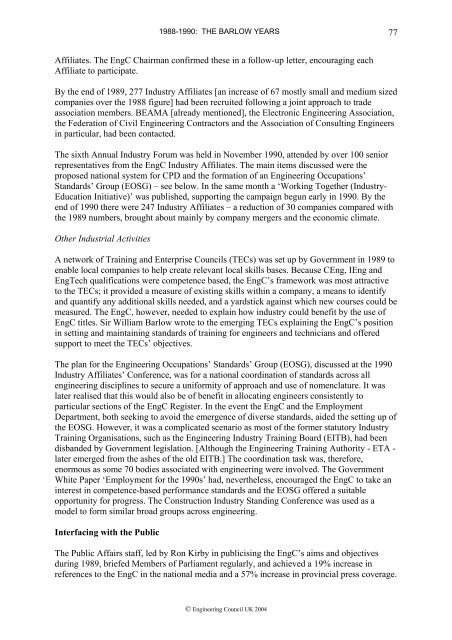An Engine for Change - A Chronicle of the Engineering Council
An Engine for Change - A Chronicle of the Engineering Council
An Engine for Change - A Chronicle of the Engineering Council
You also want an ePaper? Increase the reach of your titles
YUMPU automatically turns print PDFs into web optimized ePapers that Google loves.
1988-1990: THE BARLOW YEARS 77Affiliates. The EngC Chairman confirmed <strong>the</strong>se in a follow-up letter, encouraging eachAffiliate to participate.By <strong>the</strong> end <strong>of</strong> 1989, 277 Industry Affiliates [an increase <strong>of</strong> 67 mostly small and medium sizedcompanies over <strong>the</strong> 1988 figure] had been recruited following a joint approach to tradeassociation members. BEAMA [already mentioned], <strong>the</strong> Electronic <strong>Engine</strong>ering Association,<strong>the</strong> Federation <strong>of</strong> Civil <strong>Engine</strong>ering Contractors and <strong>the</strong> Association <strong>of</strong> Consulting <strong>Engine</strong>ersin particular, had been contacted.The sixth <strong>An</strong>nual Industry Forum was held in November 1990, attended by over 100 seniorrepresentatives from <strong>the</strong> EngC Industry Affiliates. The main items discussed were <strong>the</strong>proposed national system <strong>for</strong> CPD and <strong>the</strong> <strong>for</strong>mation <strong>of</strong> an <strong>Engine</strong>ering Occupations’Standards’ Group (EOSG) – see below. In <strong>the</strong> same month a ‘Working Toge<strong>the</strong>r (Industry-Education Initiative)’ was published, supporting <strong>the</strong> campaign begun early in 1990. By <strong>the</strong>end <strong>of</strong> 1990 <strong>the</strong>re were 247 Industry Affiliates – a reduction <strong>of</strong> 30 companies compared with<strong>the</strong> 1989 numbers, brought about mainly by company mergers and <strong>the</strong> economic climate.O<strong>the</strong>r Industrial ActivitiesA network <strong>of</strong> Training and Enterprise <strong>Council</strong>s (TECs) was set up by Government in 1989 toenable local companies to help create relevant local skills bases. Because CEng, IEng andEngTech qualifications were competence based, <strong>the</strong> EngC’s framework was most attractiveto <strong>the</strong> TECs; it provided a measure <strong>of</strong> existing skills within a company, a means to identifyand quantify any additional skills needed, and a yardstick against which new courses could bemeasured. The EngC, however, needed to explain how industry could benefit by <strong>the</strong> use <strong>of</strong>EngC titles. Sir William Barlow wrote to <strong>the</strong> emerging TECs explaining <strong>the</strong> EngC’s positionin setting and maintaining standards <strong>of</strong> training <strong>for</strong> engineers and technicians and <strong>of</strong>feredsupport to meet <strong>the</strong> TECs’ objectives.The plan <strong>for</strong> <strong>the</strong> <strong>Engine</strong>ering Occupations’ Standards’ Group (EOSG), discussed at <strong>the</strong> 1990Industry Affiliates’ Conference, was <strong>for</strong> a national coordination <strong>of</strong> standards across allengineering disciplines to secure a uni<strong>for</strong>mity <strong>of</strong> approach and use <strong>of</strong> nomenclature. It waslater realised that this would also be <strong>of</strong> benefit in allocating engineers consistently toparticular sections <strong>of</strong> <strong>the</strong> EngC Register. In <strong>the</strong> event <strong>the</strong> EngC and <strong>the</strong> EmploymentDepartment, both seeking to avoid <strong>the</strong> emergence <strong>of</strong> diverse standards, aided <strong>the</strong> setting up <strong>of</strong><strong>the</strong> EOSG. However, it was a complicated scenario as most <strong>of</strong> <strong>the</strong> <strong>for</strong>mer statutory IndustryTraining Organisations, such as <strong>the</strong> <strong>Engine</strong>ering Industry Training Board (EITB), had beendisbanded by Government legislation. [Although <strong>the</strong> <strong>Engine</strong>ering Training Authority - ETA -later emerged from <strong>the</strong> ashes <strong>of</strong> <strong>the</strong> old EITB.] The coordination task was, <strong>the</strong>re<strong>for</strong>e,enormous as some 70 bodies associated with engineering were involved. The GovernmentWhite Paper ‘Employment <strong>for</strong> <strong>the</strong> 1990s’ had, never<strong>the</strong>less, encouraged <strong>the</strong> EngC to take aninterest in competence-based per<strong>for</strong>mance standards and <strong>the</strong> EOSG <strong>of</strong>fered a suitableopportunity <strong>for</strong> progress. The Construction Industry Standing Conference was used as amodel to <strong>for</strong>m similar broad groups across engineering.Interfacing with <strong>the</strong> PublicThe Public Affairs staff, led by Ron Kirby in publicising <strong>the</strong> EngC’s aims and objectivesduring 1989, briefed Members <strong>of</strong> Parliament regularly, and achieved a 19% increase inreferences to <strong>the</strong> EngC in <strong>the</strong> national media and a 57% increase in provincial press coverage.© <strong>Engine</strong>ering <strong>Council</strong> UK 2004
















